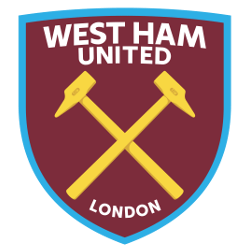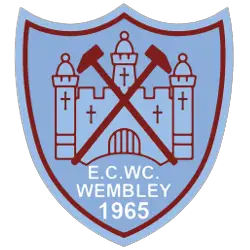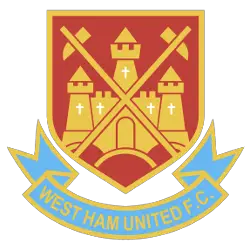 Sports Logo History
Sports Logo History West Ham United FC Primary Logo 2016 - Present
West Ham United is one of the most popular and oldest clubs in the Premier League. The famed Hammers may not be the team with the most titles in English football, but it has a long history behind it of great wins and probably the best supporters. There’s one other notable thing the club is famous for – it's the burgundy logo.
Formed in 1895 as Thames Ironwork, the club was reformed five years later with the name we know of today – West Ham United. The two hammers were introduced from the moment of ‘rebrand’, and thus started the evolution of its famous logo which is still in use today.
Burgundy and Blue
After the reformation as West Ham United in 1900, the club first introduced the logo that would stay mostly untouched to this day. The first official logo for the club was introduced in 1923. It featured two crossed hammers placed inside a circular frame. They were put on a sky-blue crest, forming the popular burgundy and blue combination that would inspire other teams as well.
 Sports Logo History
Sports Logo History West Ham United FC Primary Logo 1965 - 1968
Of course, the first West Ham logo was relatively simple and a far cry from modern logos such as the UEFA Euro 2020 logo. However, it was one of the most popular at the time and was closely linked to the club’s history. As mentioned, West Ham was originally named Thames Ironwork, and the two hammers represented the Iron part of the club. The crossed hammers and the circle around them represented unity and team game.
The crest stayed in use until 1950 when the club came up with a new idea for the logo. This time, the redesign made it much more elegant, removing the circlet from the emblem and placing the crossed hammers on a blue shield. The burgundy was gone. This new logo didn’t really appeal to the fans, so it was changed after only two short years.
In 1952, West Ham unveiled a new logo with a redesigned crest. It resembled the original logo much more, but it didn’t stay in use for a long time as the club was seeking a new modern identity. It was changed again in 1958 with a more minimalistic approach. It was a more professional and clean design, looking like an improved version of the 1950 logo.
In 1963, the logo underwent another change. This was by far the most minimalistic, scraping the blue for a white crest. This was a much more universal logo, but it wasn’t really loved by fans who wanted something better.
Moving Forward
 Sports Logo History
Sports Logo History West Ham United FC Primary Logo 1987 - 1999
The first major changes to West Ham’s logo were introduced in 1968. The sky-blue color was omitted once again, with the white shield outlined with burgundy. There was a new image as well. The two hammers were now crossed in front of a castle, with a West Ham United F.C. inscription below.
It was a redesign that sparked a slew of others that followed which gave way to the logo we have today.
The West Ham logo would be redesigned every 5-6 years more or less, with the biggest changes made in 1999. This time, the original burgundy and blue colors were back along with a new one – yellow. The logo looked like a reimagining of the one introduced in 1968 before the club reverted back to an older design in 2016.
The 2016 logo is still in use today in the Premier League. It’s a modern and sleek logo that puts the hammers back on a crest in burgundy with a sky-blue outline. The new logo is both old-school and modern, gracing the shirts of West Ham in the PL where the team has done well in the past few seasons.
See the West Ham United FC logo history and team history.
Sports Logo History is a community of sports logo enthusiast who enjoys the history of each team’s logo history. Sports Logo History has primary logos, alternate logos, wordmark logos, or concept logos from the NFL, NBA, MLB, MLS, NHL, Premier League, WNBA, CFL, NCAA, ABA, USFL, AAF, and XFL.
Our partner site is Sports Team History takes a look at the history of each and every professional sports team.

